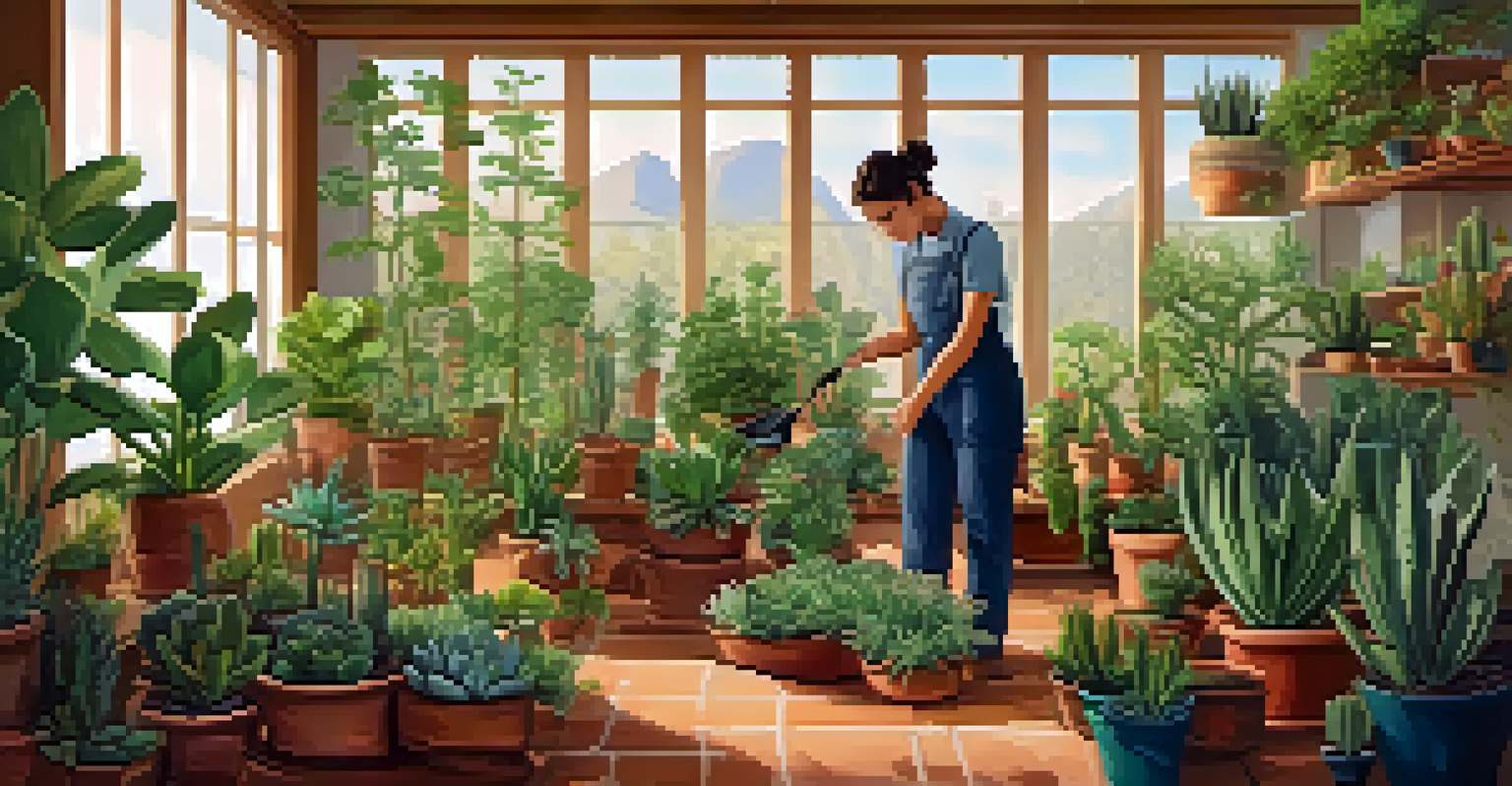Seasonal Care: Adapting Indoor Plant Care for Climate Changes

Understanding Climate Change and Its Impact on Indoor Plants
Climate change isn't just a buzzword; it affects our daily lives, including how we care for our beloved indoor plants. As temperatures rise and weather patterns shift, plants may react differently than they would in a stable environment. For instance, a plant that thrived in a consistent climate might struggle with unexpected heat waves or cold snaps.
Plants are like people; they need food, water, and light to thrive.
Understanding these changes is crucial for effective indoor plant care. It’s not just about watering and sunlight anymore; we need to consider how fluctuating temperatures and humidity levels can affect plant health. By acknowledging these factors, we can make informed decisions about how to best support our green companions.
So, as we dive into seasonal care tips, remember that your plants are sensitive to the world around them. Adapting your care routine will help them thrive, even as the climate continues to change.
Adjusting Watering Schedules with Seasonal Changes
Watering is one of the most critical aspects of indoor plant care, and it’s essential to adjust your watering schedule with the seasons. During warmer months, plants often require more water due to increased evaporation and growth rates. Conversely, in cooler months, many plants enter a dormant phase and need less frequent watering.

To determine how much to water, always check the moisture level of the soil. A simple finger test can do wonders; if the top inch of soil feels dry, it’s time for a drink. Over-watering can lead to root rot, especially in winter when plants are less active, so be cautious and adjust accordingly.
Seasonal Adjustments for Plant Care
Indoor plants require adjustments in care routines, including watering, light exposure, and humidity management, to thrive through seasonal changes.
By staying in tune with your plants' needs, you can ensure they receive the right amount of hydration to flourish throughout the year. Remember, less is often more during the colder months!
Adapting Light Conditions for Seasonal Variations
Light is another key factor that can change dramatically with the seasons. As daylight hours fluctuate, your indoor plants may need adjustments in their positioning to receive optimal sunlight. For example, during the winter, the sun is lower in the sky, which might mean moving your plants closer to windows for adequate light.
The best time to plant a tree was twenty years ago. The second best time is now.
Conversely, in the summer, too much direct sunlight can scorch leaves, especially for shade-loving varieties. Understanding your plants' specific light preferences will allow you to create a comfortable environment that mimics their natural habitat, regardless of outdoor conditions.
Moreover, consider supplementing natural light with grow lights during the darker months. This can help maintain healthy growth and prevent plants from becoming leggy or weak.
Managing Humidity Levels for Indoor Plants
Humidity plays a significant role in plant health, and it often fluctuates with the seasons. Many indoor plants thrive in higher humidity levels, which can drop during the winter months when heating systems are in use. This decrease can lead to dry, crispy leaves, especially for tropical varieties.
To combat this, consider using a humidifier or placing a tray of water near your plants to increase moisture in the air. Grouping plants together can also help create a microclimate that retains humidity. It's like giving your plants their own cozy corner to thrive in!
Fertilization Timing Matters
The timing and type of fertilizer should vary with the seasons, as plants need more nutrients during active growth in spring and summer but less during dormancy in fall and winter.
Additionally, misting your plants can provide a quick boost of humidity, but be cautious not to overdo it, as this can lead to mold. Monitoring humidity levels will ensure your plants stay healthy and vibrant, no matter the season.
Fertilizing Indoor Plants Based on Seasonal Needs
Fertilization is essential for plant growth, but the timing and type of fertilizer should vary with the seasons. In spring and summer, when plants are actively growing, they benefit from regular feeding to support new growth. However, during the fall and winter, many plants enter a resting period and require less fertilization.
Using a balanced fertilizer during the growing season will promote healthy foliage and blooms. In contrast, you might want to reduce or even halt fertilization in the colder months, allowing your plants to conserve energy. It's like giving them a well-deserved break after a busy growing season.
Always follow the recommended guidelines for your specific plant types, as over-fertilizing can lead to nutrient burn. Knowing when to feed your plants can make a world of difference in their health and appearance.
Pest Control Strategies for Seasonal Plant Care
As seasons change, so do the pests that may affect your indoor plants. Warm weather can bring an influx of bugs like aphids and spider mites, while cooler months may see a rise in fungus gnats. Being proactive about pest control is key to keeping your plants healthy and thriving.
Regularly inspecting your plants for signs of pests can help you catch infestations early. If you notice any unwanted visitors, consider using natural remedies like insecticidal soap or neem oil. These options are effective and less harmful to your plants and the environment.
Pest Control Proactivity is Key
Regularly inspecting for pests and maintaining plant hygiene can help prevent infestations, ensuring indoor plants remain healthy throughout the year.
Additionally, maintaining good plant hygiene, such as cleaning leaves and removing dead foliage, can prevent pests from making themselves at home. A little vigilance goes a long way in ensuring your plants remain pest-free throughout the year.
Seasonal Repotting: When and How to Do It
Repotting is an essential part of indoor plant care, and timing it with the seasons can make a significant difference. Spring is typically the best time to repot, as many plants are emerging from dormancy and ready to grow. This allows them to establish roots in fresh soil and continue flourishing.
When repotting, choose a pot that’s only slightly larger than the current one to avoid overwhelming the plant. Ensure that the new pot has drainage holes to prevent water from accumulating, which can lead to root rot. Using fresh potting mix will provide essential nutrients that your plant craves.

If you notice your plant becoming root-bound or the soil degrading, it’s a sign that it’s time for a change. Keeping an eye on your plants' growth patterns will help you decide when it’s time for a new home!